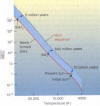




| Fusion phases for a 20-Sun star | ||
| phase/element | duration | approximate temperature of fusion |
| hydrogen | 10 million years | 10 million K |
| helium | 1 million years | 100 million K |
| carbon | 1000 years | 600 million K |
| oxygen | 1 year | 1.5 billion K |
| silicon | 1 week | 3 billion K |
| iron | <1 day | 5 billion K |
|
WATER
|
1 g/cm3
|
|
SUN
|
1.4 g/cm3
|
|
LEAD
|
11 g/cm3
|
|
CORE OF SUN
|
150 g/cm3
|
|
WHITE DWARF
|
106 g/cm3
|
|
NEUTRON STAR
|
1015 g/cm3
|
|
Initial mass (in units
of Msun)
|
Final evolutionary
state
|
Comment |
|
< 0.01
|
planet
|
|
|
0.01<M<0.08
|
brown dwarf
|
too cool to sustain consistent nuclear fusion |
|
0.08<M<0.5
|
helium white dwarf
|
too cool to fuse He to C and O |
|
0.5<M<4
|
C-O white dwarf
|
too cool to fuse C and O to heavier elements |
|
4<M<8
|
O-Ne-Mg white dwarf
|
|
|
8<M<40
|
supernova/neutron star
|
|
|
40<M
|
supernova/black hole
|
|
Fusion
|
Fission
|
|
|
Yes
|
Energy source in stars?
|
No
|
|
bombs only
|
Energy source on Earth?
|
bombs and power plants
|
|
water
|
Major source on Earth
|
uranium
|
|
helium
|
Pollution?
|
radioactive waste
|
The lifetimes of star range from around a million years for the blue giants to billion of years for the red dwarfs.
| Spectral type | Mass (in units of Solar mass) | Lifetime on main sequence (years) |
| O5 (blue giant) | 40 | 1 million |
| B0 | 16 | 11 million |
| A0 | 3.3 | 440 million |
| F0 | 1.7 | 3 billion |
| G0 | 1.1 | 8 billion |
| K0 | 0.8 | 17 billion |
| M0 (red dwarf) | 0.4 | 56 billion |
| Type I (thermal runaway) supernova | Type II (core-collapse) supernova |
| results from a white dwarf in a binary system | results from any supermassive star |
| weak hydrogen emission lines | strong hydrogen emission lines |
| leaves no core remnant behind | leaves a neutron star or black hole behind |
| light curve similar to that of a nova | light curve usually has characteristic "plateau" |
| luminosity relatively constant | luminosity has wide range |
| used as standard candle (for distance measurement) | does not help with distance |
| several times brighter than Type II supernova | about 1 billion solar luminosities |